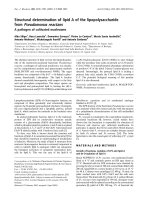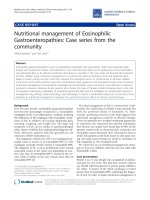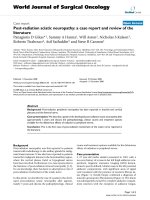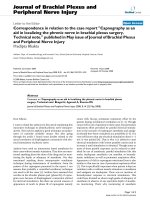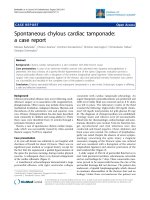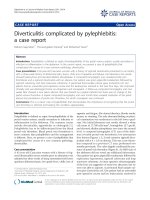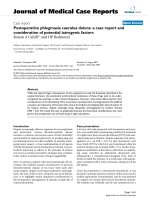Báo cáo y học: "Fatal injection of ranitidine: a case report" ppsx
Bạn đang xem bản rút gọn của tài liệu. Xem và tải ngay bản đầy đủ của tài liệu tại đây (989.87 KB, 5 trang )
BioMed Central
Page 1 of 5
(page number not for citation purposes)
Journal of Medical Case Reports
Open Access
Case report
Fatal injection of ranitidine: a case report
Antonio Oliva*
1
, Sara Partemi
1
, Vincenzo Arena
2
, Fabio De Giorgio
1
,
Catia Colecchi
1
, Nadia Fucci
3
and Vincenzo L Pascali
1
Address:
1
Institute of Legal Medicine, Catholic University, School of Medicine, Rome, Italy,
2
Institute of Pathology, Catholic University, School of
Medicine, Rome, Italy and
3
Forensic Toxicology Laboratories, Catholic University, School of Medicine, Rome, Italy
Email: Antonio Oliva* - ; Sara Partemi - ; Vincenzo Arena - ; Fabio De
Giorgio - ; Catia Colecchi - ; Nadia Fucci - ;
Vincenzo L Pascali -
* Corresponding author
Abstract
Introduction: Ranitidine hydrochloride (Zantac
®
), a histamine-2-receptor antagonist, is a widely
used medication with an excellent safety record. Anaphylactic reaction to ranitidine is an extremely
rare event and a related death has never been described in the literature.
Case presentation: We present the clinical history, histological and toxicological data of a 51-
year-old man with negative anamnesis for allergic events, who died suddenly after the intravenous
administration of one phial of Zantac
®
50 mg prescribed as a routine post-surgical prophylaxis for
stress ulcer.
Conclusion: Although the incidence of anaphylactic reactions related to ranitidine is low, caution
needs to be exercised on administration of this drug. In addition, further study is needed to define
strategies for the prevention of adverse drug reactions in hospitalized patients.
Introduction
Ranitidine hydrochloride (Zantac
®
) is a histamine-2-
receptor antagonist (H2RA) medication used in peptic
ulcer disease therapy, acute stress ulcers, gastroesophageal
reflux and related disorders (indications and dosages are
summarized in Tables 1 and 2). This medication is often
used intravenously in the operating room and during
recovery in surgical departments or intensive care units,
and orally in medical departments [1]. Ranitidine has an
excellent safety record [2,3] and we found no reports of
fatalities related to this drug in the literature, although the
incidence of anaphylactic reaction to H2RAs and proton
pump inhibitors together has been reported as 0.3% to
0.7% (see [4]). Several other adverse events are reported in
clinical trials or in the routine management of patients
treated with ranitidine [5]. Central nervous system symp-
toms such as malaise, dizziness, somnolence, insomnia
and vertigo have been reported. Rare events of reversible
mental confusion, agitation, depression and hallucina-
tions have also been described, predominantly in severely
ill elderly patients. Effects on the cardiovascular system
have included rare cases of arrhythmias such as tachycar-
dia, bradycardia, atrioventricular block and premature
ventricular beats [6]. There have been occasional reports
of hepatocellular, cholestatic or mixed hepatitis, with or
without jaundice. These events are usually reversible, but
in rare circumstances death has occurred. Cases of agran-
ulocytosis, pancytopenia, sometimes with marrow hypo-
plasia, and aplastic anemia, and exceedingly rare events of
acquired immune hemolytic anemia have been reported.
Published: 17 July 2008
Journal of Medical Case Reports 2008, 2:232 doi:10.1186/1752-1947-2-232
Received: 29 October 2007
Accepted: 17 July 2008
This article is available from: />© 2008 Oliva et al; licensee BioMed Central Ltd.
This is an Open Access article distributed under the terms of the Creative Commons Attribution License ( />),
which permits unrestricted use, distribution, and reproduction in any medium, provided the original work is properly cited.
Journal of Medical Case Reports 2008, 2:232 />Page 2 of 5
(page number not for citation purposes)
A large epidemiological study suggested an increased risk
of developing pneumonia in current users of H2RAs com-
pared with patients who had stopped H2RA treatment.
However, a causal relationship between the use of H2RAs
and pneumonia has not been established.
Case presentation
A 51-year-old man was admitted to the hospital for treat-
ment of benign prostatic hyperplasia (BPH). The patient's
anamnesis was negative for allergic events. Before hospi-
talization he was being treated with alfuzosin, which
belongs to a group of medications known as alpha-1A-
receptor antagonists used to treat the symptoms of
enlarged prostate and BPH. On admission to the hospital
alfuzosin treatment was suspended and the patient under-
went transurethral resection of the prostate under epi-
dural anesthesia, followed by post-surgical
administration of antibiotics (modivid) and lactated
Ringer's solution. Twenty-four hours after surgery, routine
prophylaxis for stress ulcer (one phial of Zantac
®
50 mg,
intravenous, in normal saline solution) was prescribed.
Within minutes of the injection of ranitidine, the patient
developed a combination of wheezing, dyspnea and
hypotension followed by loss of consciousness. Despite
intensive resuscitation attempts, no cardiac activity reap-
peared and death was certified 30 minutes later. As the cir-
cumstances of death appeared suspicious to the treating
emergency physician, a forensic investigation was initi-
ated and the public prosecutor ordered a forensic
necropsy.
The autopsy revealed pulmonary congestion with wide-
spread upper airway edema, the presence of petechial
hemorrhages and brain swelling with diffuse petechial
hemorrhages. There was no evidence of recent myocardial
infarction or other structural heart diseases. The rest of the
organs were unremarkable. Histological sections con-
firmed the presence of widespread hypolaryngeal and
pharyngeal mucosal and submucosal edema with inflam-
matory cells and an abundance of mast cells (Figure 1A
and 1B). Testing for specific IgE antibodies and mast cell
tryptase was not performed because of post-mortem deg-
radation of the serum.
Toxicological analyses on blood performed using a gas
chromatography-mass spectrometry technique revealed
the presence of ranitidine at less than 10 ng/ml (limit of
quantitation); see Figure 2. No other drugs were found.
Death was attributed to anaphylactic shock due to an
adverse reaction caused by intravenous injection of raniti-
dine, suggestive of a pathogenic mechanism of immedi-
ate-type hypersensitivity reaction type I, according to the
Gell and Coombs Classification System.
Discussion
Ranitidine, an H2RA which is commonly used to treat
peptic ulcer and gastroesophageal reflux diseases, is asso-
ciated with a low incidence of adverse reactions. Most
reports were of obstetric patients [7,8], and a case of severe
anaphylaxis to ranitidine in a patient with pancreatitis
was also reported [9]. A review of the literature revealed
no reported fatalities related to this drug.
We have presented the case of a 51-year-old man with
negative anamnesis of allergic events, who was admitted
to the hospital for treatment of BPH. During post-surgical
recovery the patient received antibiotics (modivid), lac-
tated Ringer's solution and, 24 hours after surgery, routine
prophylaxis for stress ulcer (one phial of Zantac
®
50 mg,
intravenous, in normal saline solution) was added to the
Table 1: Ranitidine: indications and adult oral dosages
Indications Dosages
Active duodenal ulcer 150 mg or 10 ml of syrup
Maintenance of healing of duodenal ulcers 150 mg or 10 ml of syrup
Pathological hypersecretory conditions (such as Zollinger-Ellison syndrome) 50 mg or 10 ml of syrup
Benign gastric ulcer 50 mg or 10 ml of syrup
Maintenance of healing of gastric ulcers 150 mg or 10 ml of syrup
Gastroesophageal reflux disease 150 mg or 10 ml of syrup
Erosive esophagitis 150 mg or 10 ml of syrup
Maintenance of healing of erosive esophagitis 150 mg or 10 ml of syrup
Table 2: Ranitidine: indications and adult intramuscular and intravenous dosages
Indications Dosages
Treatment and maintenance for duodenal ulcer, hypersecretory
conditions, gastroesophageal reflux.
Intramuscular: 50 mg q 6–8 hr
Intermittent intravenous injection or infusion: 50 mg q 6–8 hr,
not to exceed 400 mg/day.
Continuous intravenous infusion: 6.25 mg/hr
Journal of Medical Case Reports 2008, 2:232 />Page 3 of 5
(page number not for citation purposes)
therapy. Within minutes of the injection of ranitidine
clinical symptoms manifested in a combination of wheez-
ing, dyspnea and hypotension followed by loss of con-
sciousness and, despite intensive resuscitation attempts,
no cardiac activity reappeared and death was certified 30
minutes later.
In accordance with the literature [10] both autopsy and
histological investigations showed the most common
post-mortem findings related to anaphylaxis, such as pul-
monary congestion with upper airway edema, presence of
petechial hemorrhages, brain swelling with diffuse
petechial hemorrhages, the widespread presence of
inflammatory cells and abundance of mast cells. Subse-
quent testing for specific IgE antibodies and mast cell tryp-
tase was not performed because of post-mortem
degradation of the serum. Despite these limitations, our
results (clinical history, autopsy, histological and toxico-
logical analyses) are highly suggestive of an anaphylactic
reaction caused by ranitidine.
What lessons can learned from this case? It is hard to pick
up a medical journal today without reading about some
new medication, and how it promises to completely
change the course of a disease or symptoms. The wonders
of pharmacology are numerous but, as always, medica-
tions old or new are a double-edged sword. Much of the
recent research on problems with medications has
focused primarily on errors in medication use [11,12].
This is an important area of research, but adverse drug
reactions (ADRs) that are not preventable, given our cur-
rent state of knowledge, are a more common problem
with a greater human burden. The question is whether the
tracking of non-preventable drug-related injuries is
important, especially when it is known that a specific drug
can cause a specific reaction. It is important, for several
reasons. Avoiding administration of the same medication
to the patient in the future requires knowing and docu-
menting that the patient had a previous allergy or sensitiv-
ity. When a patient develops an allergy or sensitivity, this
information is often not recorded, resulting in patients
receiving drugs to which they have known allergies or sen-
sitivities: could this have happened in our case? Until the
use of electronic medical records becomes ubiquitous
[13], other initiatives must be undertaken to lower the
incidence of ADRs. Health plans and pharmacy managers
must work together to take effective steps to increase ADR
monitoring and reporting and to proactively avoid ADRs
through use of pharmacy management tools.
Another important and related issue is that hospitals have
had strong incentives not to identify too many of these
events [14]. Reporting large numbers of adverse events
and any serious preventable event brings intense scrutiny
from regulators and the public. Thus, most hospitals have
relied on spontaneous reporting, which only identifies
about 1 in 20 adverse reactions and leads to the percep-
tion that injuries from ADRs are less common than they
really are [15].
For all of these reasons, areas of ongoing research need to
be improved and directed toward diagnostic precision
and accurate monitoring of ADRs, including further
understanding of the immunochemistry of allergenic
medications, improvement of the reproducibility and sen-
sitivity of relevant IgE in vitro assays, and further valida-
tion of computer-assisted evaluation of adverse drug
events. Moreover, the positive and negative predictive val-
ues for these diagnostic tests need to be better defined,
whenever possible. At present, the primary diagnostic tool
Histological examinationFigure 1
Histological examination. Immunohistochemical exami-
nations (mouse anti – human monoclonal Mast Cell Tryptase
(diluition 1:100; DAKO, Italy), demonstrated an increased
number of mast cells in laryngeal submucosa (A) with
perivascular localization (B).
Journal of Medical Case Reports 2008, 2:232 />Page 4 of 5
(page number not for citation purposes)
for properly assessing immunological drug reactions
remains a meticulous and detailed history obtained by an
astute, knowledgeable and motivated physician.
Conclusion
We have described the only fatal reaction related to raniti-
dine in the literature to date. Reactions to this extensively
used drug are very rare in clinical practice. However, this
case suggests that, although the incidence of anaphylactic
reactions related to ranitidine is low, caution needs to be
exercised on administration of this drug. In addition, fur-
ther study is needed to define strategies for the prevention
of ADRs in hospitalized patients.
Abbreviations
ADR: Adverse drug reaction; BPH: Benign prostatic hyper-
plasia; H2RA: Histamine-2-receptor antagonist.
Competing interests
The authors declare that they have no competing interests.
Consent
Written informed consent was obtained from the patient's
next-of-kin for publication of this case report and accom-
panying images. A copy of the written consent is available
for review by the Editor-in-Chief of this journal.
Authors' contributions
AO and SP performed the autopsy examination and are
responsible for the conception and design of the manu-
script. VA performed the histological analysis. NF pro-
vided the toxicological results. FDG and CC performed
the review of the literature. VLP is the supervisor of the
manuscript. All the authors read and approved the final
manuscript.
Toxicological analysisFigure 2
Toxicological analysis. Gas chromatography-mass spectrometry analysis shows the presence of ranitidine at the following
concentrations: <10 ng/ml (limit of quantitation).
Publish with BioMed Central and every
scientist can read your work free of charge
"BioMed Central will be the most significant development for
disseminating the results of biomedical research in our lifetime."
Sir Paul Nurse, Cancer Research UK
Your research papers will be:
available free of charge to the entire biomedical community
peer reviewed and published immediately upon acceptance
cited in PubMed and archived on PubMed Central
yours — you keep the copyright
Submit your manuscript here:
/>BioMedcentral
Journal of Medical Case Reports 2008, 2:232 />Page 5 of 5
(page number not for citation purposes)
Aknowledgments
This study has been supported by Fondi di Ateneo, Linea
D1, Università Cattolica del Sacro Cuore.
References
1. Parente F, Cucino C, Gallus S, Bargiggia S, Greco S, Pastore L, Bianchi
Porro G: Hospital use of acid-suppressive medications and its
fall-out on prescribing in general practice: a 1-month survey.
Aliment Pharmacol Ther 2003, 17:1503-1506.
2. Frampton JE, McTavish D: Ranitidine: a pharmacoeconomic
evaluation of its use in acid-related disorders. Pharmacoeco-
nomics 1994, 6:57-89.
3. Grant SM, Langtry HD, Brogden RN: Ranitidine. An updated
review of its pharmacodynamic and pharmacokinetic prop-
erties and therapeutic use in peptic ulcer disease and other
allied diseases. Drugs 1989, 37:801-870.
4. Demirkan K, Bozkurt B, Karakaya G, Kalyoncu AF: Anaphylactic
reaction to drugs commonly used for gastrointestinal sys-
tem diseases: 3 case reports and review of the literature. J
Investig Allergol Clin Immunol 2006, 16:203-209.
5. Gisbert JP, González L, Calvet X, Roqué M, Gabriel R, Pajares JM:
Proton pump inhibitors versus H2-Antagonist: a meta-anal-
ysis of their efficacy in treating bleeding peptic ulcer. Aliment
Pharamacol Ther 2001, 15:917.
6. Katzung B: Basic & Clinical Pharmacology 9th edition. New York:
McGraw-Hill Companies; 2004.
7. Powell JA, Maycock EJ: Anaphylactoid reaction to ranitidine in
an obstetric patient. Anaesth Intensive Care 1993, 21:702-703.
8. Barry JE, Madan R, Hewitt PB: Anaphylactoid reaction to raniti-
dine in an obstetric patient. Anaesthesia 1992, 47:360-361.
9. Rethnam U, Yesuplan RS: Anaphylactic reaction associated with
ranitidine in a patient with acute pancreatitis: a case report.
J Med Case Reports 2007, 1:75.
10. Pumphrey RS, Roberts IS: Postmortem findings after fatal ana-
phylactic reactions. J Clin Pathol 2000, 53:273-276.
11. Phillips DP, Christenfeld N, Glynn LM: Increase in US medication-
error deaths between 1983 and 1993. Lancet 1998,
351:643-644.
12. Bates DW, Cullen DJ, Laird N, Petersen LA, Small SD, Servi D, Laffel
G, Sweitzer BJ, Shea BF, Hallisey R: Incidence of adverse drug
events and potential adverse drug events: implications for
prevention. ADE Prevention Study Group. JAMA 1995,
274:29-34.
13. Classen DC, Pestotnik SL, Evans RC, Burke JP: Computerized sur-
veillance of adverse drug events in hospital patient. JAMA
1991, 266:2847-2851.
14. Bates DW: Drugs and adverse drug reactions: how worried
should be? JAMA 1998, 279:1216-1217.
15. Cullen DJ, Bates DW, Small SD, Cooper JB, Nemeskal AR, Leape LL:
The incident reporting system does not detect adverse drug
events: a problem for quality improvement. J Comm J Qual
Improv 1995, 21:541-48.
